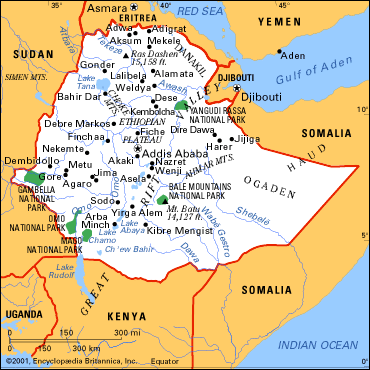 |
|
The flag is red (for sacrifice), green (for labor, development, and fertility), and yellow (for hope, justice, and equality). Tricolor pennants were used prior to the official flag of Oct. 6, 1897, and a tricolor was flown by antigovernment forces in 1991. On Feb. 6, 1996, the disk (for peace) and star (for unity and the future) were added. |
|
 
Official name: Federal Democratic Republic of Ethiopia.
Form of government: federal republic with two legislative houses (Federal Council [117]; Council of People's Representatives [548]).
Chief of state: President.
Head of government: Prime Minister.
Population (1998): 58,390,000.
Population projection: (2000) 60,967,000; (2010) 74,832,000.
Natural increase rate per 1,000 population (1995-2000): 32.0 (world avg. 15.7).
Gross national product (1996): U.S.$6,042,000,000 (U.S.$100 per capita).
Land use (1994): forest 13.3%; pasture 20.0%; agriculture 11.0%; other 55.7%.
|
